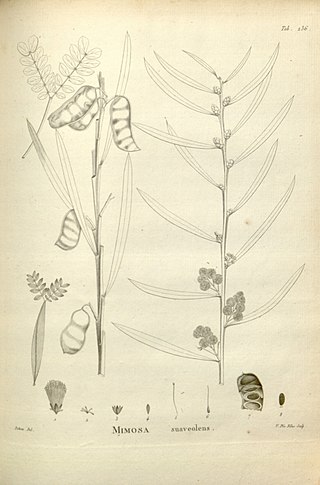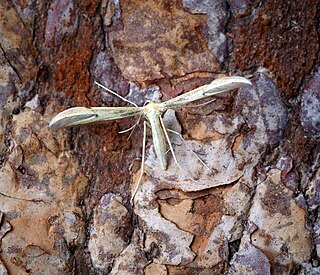
The golden samphire is a perennial coastal species, which may be found growing on salt marsh or sea cliffs across western and southern Europe and the Mediterranean.

Inula is a genus of about 80 species of flowering plants in the family Asteraceae, native to Europe, Asia and Africa.

Phyllodes are modified petioles or leaf stems, which are leaf-like in appearance and function. In some plants, these become flattened and widened, while the leaf itself becomes reduced or vanishes altogether. Thus the phyllode comes to serve the purpose of the leaf. Some important examples are Euphorbia royleana which are cylindrical and Opuntia which are flattened.

Elecampane, pronounced and also called horse-heal or elfdock, is a widespread plant species in the sunflower family Asteraceae. It is native to Eurasia from Spain to Xinjiang province in western China, and naturalized in parts of North America.

Inula racemosa is an Asian plant in the daisy family native to the temperate and alpine western Himalayas of Xinjiang, Afghanistan, Kashmir, Nepal, Pakistan.

Carl Christian Mez was a German botanist and university professor. He is denoted by the author abbreviation Mez when citing a botanical name.
Pommereulla is a genus of Indian and Sri Lankan plants in the grass family. The only known species is Pommereulla cornucopiae, native to Sri Lanka and Tamil Nadu. The genus is dedicated to Elizabeth Jullienne du Gage de Pommereul (1733-1782), a French female botanist.
Moquinia is a genus of flowering plants in the tribe Moquinieae within the family Asteraceae.

Pentanema salicinum is a plant species in the family Asteraceae. It is found across Eurasia from Portugal to Japan. It has been reported growing in the wild in a few scattered locations in North America but it has not become widely established there.

Axillarin is an O-methylated flavonol. It can be found in Pulicaria crispa, Filifolium sibiricum, Inula britannica, Wyethia bolanderi in Balsamorhiza macrophylla and in Tanacetum vulgare. It can also be synthesized.

Pentanema britannica, the British yellowhead or meadow fleabane, is a Eurasian species of plant in the daisy family. It is widespread across much of Europe and Asia, and sparingly naturalized in scattered locations in North America.

Coleophora follicularis is a moth of the family Coleophoridae. The species was first described in 1802 by Jean Nicolas Vallot, a French entomologist. It is found in all of Europe.

Dittrichia viscosa, also known as false yellowhead, woody fleabane, sticky fleabane and yellow fleabane, is a flowering plant in the daisy family.

Hellinsia carphodactyla is a moth of the family Pterophoridae, first described by Jacob Hübner in 1813. It is known from most of Europe, Asia Minor and North Africa.

Pentanema hirtum is a species of perennial herbaceous plant belonging to the family Asteraceae. The specific Latin name hirtum refers to the type of hairiness of the plant.

Pentanema spiraeifolium is a species perennial herbaceous plant belonging to the family Asteraceae. It is found from Europe to Iran.

Pentanema squarrosum, known as ploughman's-spikenard, is a species of plant in the family Asteraceae found in Europe, North Africa, and the Near East.

Euphorbia royleana is a species of flowering plant in the family Euphorbiaceae. It is also known as Sullu spurge, and Royle's spurge. It is a succulent and almost cactus like in appearance although unrelated. It grows right across the Himalaya mountains from Pakistan, India, Bhutan, Myanmar, Nepal to western China. It prefers dry and rocky slopes between 1000 and 1500 meters, but has been found up to 2000 meters. Flowering and fruiting is in spring to early summer (March–July) and seeding is in June–October. It is used as a hedging plant in northern India and has medicinal uses.
Lallemantia royleana is a species of flowering plant in the mint family, Lamiaceae. In Iran it is known as balangu shirazi and it is used as a folk medicine treatment for fever and coughs. Its seeds are a good source of polysaccharides, fiber, oil, and protein.

Inula hookeri, Hooker's inula or Hooker's fleabane, is a species of flowering plant in the sunflower and daisy family Asteraceae. It is a native of the Himalayas, India (Sikkim), Myanmar and China, where it grows in a variety of open habitats at 2,400–3,600 m (7,900–11,800 ft).

















